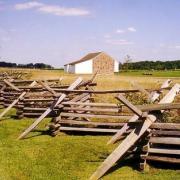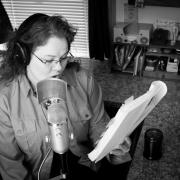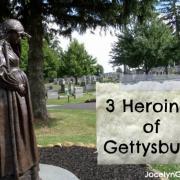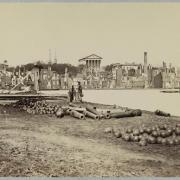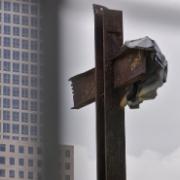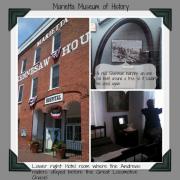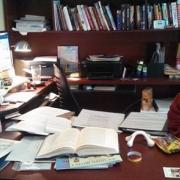Today I'm thrilled to be sharing an interview with the very talented Laura's Voice, who brings Widow of Gettysburg to life in audio book format. I hope you'll enjoy learning about it from Laura as much as I did.
Jocelyn: How do you choose which books you want to lend your voice to?
Laura: Whatever I do, I want to help share a message that is inspiring, edifying, or juicily entertaining--or all three!
Tell us about your process once you've contracted to do the narration.
I like to print the manuscript and I still use a pencil--creating a character list of each one's first appearance and first speaking part, along with any notes from the text that describes his/her personality, voice, tone attitude, etc. In the margins, I make notes of any kind that occur to me--typos (as a former English teacher and technical writer, I simply can't help myself!), and other corrections, moments where I want to emote in a certain way--then I may add a smiley face, a sad face, exclamation points, etc. After an entire read-through, I'll go back to the author/publisher with any questions I may have. I create a sample for the client to listen to and get their approval and, if necessary, will also include a character sample to ensure he/she likes the voices I create for each character. Once we have final agreement on tone, character voices, pronunciations, and any corrections that alter the text, I record and edit the text, creating .mp3 files for the listener!
[[{"type":"media", "view_mode":"media_large", "fid":"1289", "attributes":{"class":"media-image wp-image-3349", "typeof":"foaf:Image", "style":"", "width":"550", "height":"366", "alt":"This markup picture shows where I had to switch from Harrison to a commanding officer to the young soldier who overstuffed his rifle and kept chanting to himself."}}]] This markup picture shows where I had to switch from Harrison to a commanding officer to the young soldier who overstuffed his rifle and kept chanting to himself.
I see you've noted Harrison's voice as deep but clear. That's exactly how I imagined it, too! How do you create the different voices and accents for the characters?
In addition to what I described in the answer to Q2, when a character is said to be from a particular region, I study that region's accents (by listening to folks on YouTube) and practice, practice, practice!
I love how you captured the various accents in Widow! How else do you mark up the text?
I like to underline lines or phrases I especially like--just in case I have the chance to tell the author--it's always nice to hear what someone likes about your work! I have also printed pictures of places and maps of regions to have with me as I read the manuscript in order to get to know the content better. [[{"type":"media", "view_mode":"media_large", "fid":"1290", "attributes":{"class":"media-image aligncenter wp-image-3351", "typeof":"foaf:Image", "style":"", "width":"550", "height":"489", "alt":"LaurasVoicetext2"}}]]
Take us behind the scenes on a recording day. How much time do you spend in a recording session, and how many times do you typically read the same passage?
I like to have everything done to avoid interruptions--wait until the kids are on the bus, make sure the dogs have gone potty, wait at least a half-hour after brushing my teeth and have been drinking plenty of water so my mouth isn't dry, etc. I like to break the reading up into chunks--most easily by chapters, but if a chapter is particularly long, I find a good stopping point within the chapter.
[[{"type":"media", "view_mode":"media_large", "fid":"1291", "attributes":{"class":"media-image wp-image-3353", "typeof":"foaf:Image", "style":"", "width":"550", "height":"310", "alt":"LaurasVoicestudio"}}]] Where the magic happens!
Now, if the section I'm working on has a lot of difficult voices--male, gruff, deep, or perhaps a character is sick, wounded--anything that would cause strain and take extra energy to act out--I may be limited to only about half an hour of recording. It could take several hours or even another day before I can return to recording! If a passage is difficult, it may be due to long sentences, multi-syllabic words, older style of speaking, or a number of character voice changes. Those may require several takes--so I'll stop, wait a couple of seconds, say "Take Two" (or sometimes three, four, five, six, grrrrr . . . . (and restart from a moment when there was a natural stop because of a paragraph break, punctuation, or breathing. [[{"type":"media", "view_mode":"media_large", "fid":"1292", "attributes":{"class":"media-image alignleft wp-image-3208 size-full", "typeof":"foaf:Image", "style":"", "width":"300", "height":"300", "alt":"widowaudible"}}]]
I'm sure that different projects require you to strike different tones, from upbeat and energetic to slow and thoughtful. How would you describe the tone (or tones) you employed for Widow of Gettysburg?
Widow of Gettysburg required a lot of different tones--from memories, life-changing considerations, guilt and regret, longing, love and loss, renewed love, evil and lust for power. There were times I had to read a passage to myself before recording to get into the right mood--maybe even practice the passage a bit to get just the right amount of remorse Silas felt, or anger and frustration both Bella and Libbie had with each other--especially as Bella kept her secret. Amelia was one of my favorite characters to capture her various tones depending on her audience the moment and the events and how they altered her perception--or clarified her position.
[[{"type":"media", "view_mode":"media_large", "fid":"1293", "attributes":{"class":"media-image wp-image-3360 size-medium", "typeof":"foaf:Image", "style":"", "width":"300", "height":"200", "alt":"LaurasVoiceheadshot"}}]] Laura
Amelia was really fun to write! What do you think would surprise the rest of us about your work as a voice actress? Perhaps the people I've consulted in an effort to get the correct pronunciation for a town. A lot of terms I can Google--but not all! Taneytown, as it's pronounced, cannot be found ANYWHERE on the Internet! I ended up calling the Adams County courthouse and asked the first person to pick up the phone how she pronounced it! For other projects, I've consulted scientists for help with nine-syllable chemicals and related formulas; a banker and our local economic development corporation for help in reading aloud the acronyms for various programs and forms needed to obtain the correct licenses. That may be one of the most fun tasks is tracking down the pronunciation or accent that a story requires and once I've had success--! I usually have to call my mom to tell her I did it! My dogs just aren't quite enthusiastic enough. I think the other thing is that, locally, people are quite surprised someone in a town of less than 9K is the voice for books they very well might listen to--it's always nice to see the wonder on a person's face. :)
That is so neat! Thank you so much for being with us and sharing how you do your job! I found it fascinating!
Listen to the first scene of Widow by clicking "Sample" beneath the audiobook cover on this page.
If you enjoyed this "behind the scenes" post, you may also enjoy:
Behind the Scenes: The Making of a Book Trailer (Wedded to War)
Revealed: Evolution of a Book Cover (Widow of Gettysburg)
The Writing Life: A Single Scene in the Making (Yankee in Atlanta)
The Making of a Book Cover (A Refuge Assured)
Why Does It Take So Long? Book Publishing from Conception to Publication


